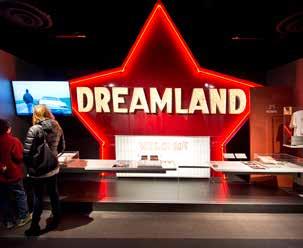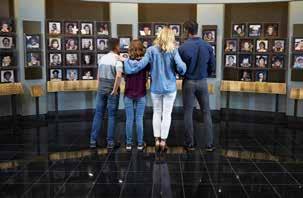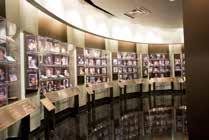


“




“
Excerpt from the Memorial Mission statement adopted March 1996.
The Memorial and Museum tell the story of April 19, 1995. On that day, 168 people were killed in the bombing of the Alfred P. Murrah Federal Building in downtown Oklahoma City. The Outdoor Memorial is meant to be symbolic while the Museum tells the story of the people impacted and how so many came from near and far to help in our darkest hour.
The Museum, a 50,000-square-foot, highly interactive learning center, tells the facts and the stories of the bombing, the recovery, and the relevance of continuing to teach the lessons of the senselessness of violence.
The Museum’s story is told in chapters much like a book. It starts with the Mission Statement in the lobby setting the tone for what is about to be told …

• April 19, 1995, begins as an ordinary day in Oklahoma City. Look at the mural on the wall and find the Alfred P. Murrah Federal Building; this sets the scene.
• Before April 19, terrorism is NOT a household word in America. To many, it seemed like terrorism was committed only by foreigners in distant places.
• Even though, in the decade before the Oklahoma City bombing, there were over 50 acts of domestic terrorism across the United States.
• Make sure you glance at the headlines of the newspapers from the day.
• Spend a couple of minutes and let Oklahoma’s own Kristin Chenoweth set the tone for your experience in the Orientation Video.

• Learn about the history of the Murrah Building. Dedicated in 1974, the 9-story building included 17 federal agencies, a snack bar, credit union and a day care.
• The Journal Record Building, located across Fifth Street, had 22 offices.
• Investigate the History of the Site interactive, where you can explore the site before the bombing and what it looks like today.
• Understand the rise of extremism in the United States. In 1993, a religious group known as the Branch Davidians is suspected of possessing illegal weapons. Following failed negotiations and a 51-day standoff, the FBI mounted an assault on the Waco, Texas, compound. More than 75 Branch Davidians died. This story played a big part in shaping the young former American soldier Timothy McVeigh’s beliefs, and influenced his antigovernment viewpoints, causing him to try to get even with the federal government.

• An Oklahoma Water Resources Board hearing was going on the morning of April 19, 1995.
• The hearing convenes at 9:00 a.m. You can listen to the discussion around a permit to bottle ground water.
• Two minutes in, you hear the sound of the blast followed by the chaos and how in one instant lives were changed forever.


• See the sights and sounds as the Channel 9 helicopter catches the first glimpse of the bombed Murrah Building and people try to make sense of what is happening.
• Hear the first 911 calls from reporters and people nearby the Federal Courthouse.
• Personal artifacts fill this space — things that belonged to those who were killed and those who survived.
• The site is surrounded by churches. The window frame is from the First Methodist Church to the east of the building, a Celtic Cross came from St. Paul’s Episcopal Cathedral to the north. The Catholic Rectory was destroyed at St. Joseph’s to the west. This is also the first time federal dollars were used to build back churches due to an attack on the government.

• Begin to understand from the survivors’ perspectives through videos, interactives and artifacts.
• The Ryder truck axle (found within the first hour after the bombing) became a key piece of evidence that tied the rental truck to Elliott’s Body Shop in Junction City, Kansas, rented by Robert Kling, an alias used by Timothy James McVeigh.
• Law enforcement officials cordoned off a 20-block crime scene and searched for evidence scattered among the 450 tons of debris.
• Learn personal stories from some 271 Survivors.



• Surround yourself in a fast-paced media environment that is so different from what we know today.
• Remember, CNN was the only 24-hour news network in 1995. The internet was in its infancy and social media did not exist.
• Look at the first photograph transmitted via Associated Press (located in the case with the TV camera), which took 3 minutes to send.
• Hear the stories of journalists who worked this story around the clock and the lessons they learned from covering what remains the largest domestic terrorist attack on American soil.

• This is the last 16 days of rescue and recovery efforts as workers sift through rubble bucket by bucket.
• National Prayer Service held at the fairgrounds and organized by Oklahoma’s former First Lady Cathy Keating four days after the bombing. Rev. Billy Graham came to speak, along with President Bill Clinton and most of his cabinet. The public stood in line for hours to come be a part of this.
• Police work was underway and the piecing together of the evidence was pointing to the motel where McVeigh stayed and evidence of what was found in accomplice Terry Nichols’ home.
• A commitment was made to the families: they would know information before it was given to the press and would get daily updates from the Governor or Mayor at the Family Assistance Center stationed inside the First Christian Church.

• Photos, personal artifacts, interactive videos and oral histories from family members and friends tell the stories of the 168 people who were killed on April 19. This room puts a face on terrorism.
• Pick a favorite artifact, learn more about it and why the family selected it in the interactives. What item or artifact would someone choose for you?



• The community came together to heal. Check out the timeline that shows how it was done.
• A 100+ year-old American elm called the Survivor Tree was the only shade in a parking lot. It was burned and badly damaged, but survived. The Memorial Mission Statement declared the tree should stay and become a part of the Memorial.
• Take a look at some of the first items left on the fence when it was installed to protect the Murrah footprint after the building was cleared.
• Listen to the Museum interactive of the community who came together to help us.


• Track the trail of evidence, review the crime scene and photos as law enforcement agencies across the country work to put the pieces of the crime together.
• The car McVeigh was driving when he was arrested became a key piece of evidence. There was a packet of anti-government material in an envelope in the front seat. McVeigh had a handgun on him when he was pulled over as well as other items including a knife and ear plugs. These are all on display in this area.
• The first federal trial began almost two years after the bombing on March 31, 1997. The Oklahoma state trial started in 2004. From beginning to end, the legal process took more than nine years. Locations were moved to Denver, Colorado, fearing impartiality from a jury would be unlikely in Oklahoma City.
• On June 2, 1997, Timothy McVeigh was convicted of 11 federal counts, including eight counts of first-degree murder for the eight federal agents killed in the bombing. The other three counts related to the making and use of a weapon of mass destruction. He was sentenced to death and was executed by lethal injection in Terre Haute, Indiana, on June 11, 2001.
• Terry Nichols was charged with the same 11 federal counts as McVeigh and on December 23, 1997, was found guilty of only one bombrelated count and eight counts of involuntary manslaughter for the agents’ deaths.
In 2004, Terry Nichols was tried by the State of Oklahoma for murder of the remaining 160 civilian victims and the loss of an unborn child. Again, the location of the trial was changed, this time to McAlester, Oklahoma, and lasted three months. Terry Nichols was convicted on all counts. He was given life sentences in the federal and state trials and is serving his time in Florence, Colorado, at a supermax prison.
• Michael Fortier was sentenced to 12 years in prison for never warning anyone about McVeigh’s plans. His wife, Lori, received immunity and turned State’s evidence. Fortier was released after serving 10 years and five months of his sentence and was released into the Witness Protection Program.
• In the closing of the state trial, Justice Steven Taylor said to Terry Nichols, as he gave him his life sentence: “It is truly ironic that the very government and the Constitution … you professed to hate is the very government that assured you a fair trial and protected your rights.”

• The one damaged area of the Journal Record Building was not repaired. It is remarkable that no one in this building was killed. This is a men’s restroom (we thought everyone could relate to a public restroom) and the closet of The Journal Record newspaper editor is also salvaged. This shows the impact of the blast.
• As you consider the damage, the loss of life, the amazing police work and the heroic response, you are given hope in that even in the very worst of times, people can be at their best.
• The Museum facility was The Journal Record newspaper building on the day of the bombing. The building was originally built as a Masonic Temple in 1923 and designed by Solomon Andrew Layton, who also designed the Oklahoma State Capitol.
• Even though 300 buildings were damaged in the bombing, the area devastated by the bomb has been rebuilt. There is a new fully occupied federal building across the street. Automobile Alley, Midtown and Downtown have been redeveloped.

• As you conclude your tour, you are shown six modern-day scenarios where you are given a choice and a consequence. These all relate back to lessons learned in the 1995 bombing.
• Look out onto the Memorial grounds from the Overlook and see the skyline of a city forever changing, but keeping guard over the 168 empty chairs.
• Learn about the Oklahoma Standard, a term coined by national journalists to describe how Oklahomans responded during the time of the trial. Service, Honor and Kindness make up the three tenets of the Oklahoma Standard.
• The Memorialization Process: Oklahoma City paved the way on how to memorialize and remember. Today, people come from across the world to study our model and learn how, why, and what we did to create this National Memorial.
• There is also a new resolve with the rise of terrorism since 1995 that has changed our lives. Did you know even today there isn’t a law against domestic terrorism? That’s why the federal trials could only prosecute for the deaths of the eight federal law enforcement officers. What causes people to become so radicalized they commit violent acts of terrorism? What are the pros and cons of having a domestic terrorism law? What can we do to stop hate speech and attacks on people simply because they look different or think differently?

• Learn the story of the Oklahoma City bombing through STEM in our Inasmuch Uncover-Discover Lab. There are three lessons available. The lab can be used for classrooms, clubs or team building.
• The Better Conversations Pit provides an area to gather students, coworkers or groups to have a conversation about a topic where everyone may not agree but where all can work on civility and try to find Common Ground.
• Both of these areas can be used by students and adults alike and we are watching lives changed by these lessons daily.
• On this Sacred Ground we find Common Ground, understanding the symbolic elements of the Oklahoma City National Memorial.

• The Museum entrance is just off the children’s area. This is designed so children of all ages can leave messages of hope, much like they did in 1995. It makes a special place where people can enter the Museum and learn the details of the story.
• Rescuers’ Orchard: this area is the fruit and flower bearing trees that surround the Survivor Tree. The message on the wall around the Survivor Tree facing the orchard says, “To the courageous and caring who responded from near and far, we offer you our eternal gratitude.”
• Survivor Tree: the now 100+ year-old American elm stands at the highest point of the Memorial grounds, standing guard as a symbol of strength and resilience. The elevated promontory that encircles the tree is a place for gathering and reflecting. The quote on the inside of the promontory is taken from Rev. Billy Graham’s message on April 23, 1995, at the National Prayer Service: “The spirit of this city and nation will not be defeated, our deeply rooted faith sustains us.” We harvest and give away saplings each April.
• Gates of Time: The 9:01 (east) Gate marks the moment of innocence before the bombing and the 9:03 (west) Gate marks the moment after the bombing when healing began. These two five-story gates frame the moment of 9:02 when we were all changed forever.
• Reflecting Pool: The 380-foot, 3/4-inch-deep pool sits where Fifth Street was in 1995. The black granite was selected to resemble the asphalt of Fifth Street where the Ryder truck was parked and so much happened after the bombing. The designers’ goal was for visitors to look into this shallow pool and see their face, one that was changed forever by their visit here.
• Survivor Wall: More than 600 names of those who survived the blast are etched on granite salvaged from the Murrah Building and mounted on the building’s only remaining walls.
• Field of Empty Chairs: Located on the footprint of the Murrah Federal Building, the chairs are in nine rows representing the nine floors of the Murrah Building and reflect where people were working or where they were visiting. Each of the 168 chairs is etched with the victim’s name and are lit at night as beacons of hope. The 19 smaller chairs represent the children killed in the bombing.
• The Fence: Originally installed to protect the footprint of the building, items began to be placed on the fence where people would leave tokens of hope and healing, and still do today. Many of these items are preserved in the Memorial Archives.
• The Murrah Plaza Overlook: The surviving area once designed to be an entrance to the building offers a sobering view of the Memorial grounds today.

• Mayor Ron Norick appointed a 350-member task force that would determine what would become of the bomb site. The federal government brought down the Murrah Building 35 days after the bombing, knowing there were at least two victims buried beneath the rubble. After the building came down, a third victim (a visitor to the building) was found, bringing the total killed to 168. There were more than 644 survivors and 370 Emergency Response and Support Agencies, including 11 Urban Search and Rescue Teams that came from around the country.
• The Memorial design was discovered through an international design competition held in 1997 and the Memorial design was announced to the public in July 1998. The Memorial was designed by Hans and Torrey Butzer with Sven Berg. Ground was broken in October 1998 and dedicated by President Bill Clinton on April 19, 2000, the fifth anniversary.
• The Memorial is a 3.3-acre site which includes the footprint of the former Alfred P. Murrah Federal Building, the city street on which the truck was parked, the alley and the parking lot and buildings across the street.
• The Museum design was selected from five finalists of some of the greatest museum designers in the country. Patrick Gallagher, with Gallagher & Associates, designed the Museum and has remained our consultant on redesign and enhancements for more than two decades.
• Lippert Bros Construction, Oklahoma City, Oklahoma, built the Memorial and Museum. Exhibit Concepts, Vandalia, Ohio, produced the exhibits. Hillmann & Carr, Washington, D.C., was the primary video producer and Cortina Productions, McClean, VA, produced all the interactives and a couple of videos throughout the Museum. Memorial & Museum staff produced all of the oral histories and several videos in the Museum.
• The Memorial and Museum are owned and operated by the Oklahoma City National Memorial Foundation, a 501(c)(3) organization, and maintains a cooperative agreement with the National Park Service to interpret the outdoor Memorial and work mutually on several educational programs. The Memorial receives no annual appropriations from city, state or federal governments.
• The Journal Record Building was saved by the City of OKC after the bombing, later turned into a condo commercial unit. The Memorial Museum is on the west end and the Heritage Trust partners on the east side.
• To learn more about the Oklahoma City National Memorial & Museum visit our website at MemorialMuseum.com .


